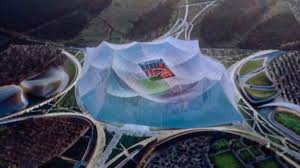May 22 – Morocco has launched the construction tender for the Grand Stade Hassan II, a centrepiece of its 2030 World Cup ambitions and a strong contender to host the tournament’s final.
The 115,000-capacity venue, located in the Benslimane province just east of Casablanca, is projected to become the largest football stadium in the world upon completion in a bid to wrestle hosting the final away from Spain’s 85,000-seater Santiago Bernabéu Stadium.
The tender, issued this week, covers the second phase of construction with a budget of $320 million, following the near completion of a $35.6 million earthworks package awarded to local firm SGTM. The submission deadline is June 10, with a build timeline of 30 months from the service order – setting completion for late 2027, comfortably ahead of the 2030 World Cup.
Designed by global stadium specialists Populous in collaboration with Oualalou + Choi, the stadium draws architectural inspiration from Morocco’s traditional ‘moussem’ gatherings, evoking a massive tented roof structure that rises dramatically from the Beni Amer Forest landscape.
Internally, the stadium bowl will feature three steep tiers at each end, designed to maximise atmosphere and accommodate nearly 60,000 fans between them. The side stands will house five levels of VVIP, VIP, and hospitality seating, with capacity for 12,000 high-tier guests, including a dedicated Royal Box.
The stadium will anchor a 100-hectare sports and leisure district, including a hotel, athletics stadium, conference centre, training pitches, retail, and parking for over 10,000 vehicles.
The Casablanca-Settat regional government has earmarked 5.1 billion dirhams ($520 million) for the broader project, including upgrades to infrastructure and communications links to eliminate bottlenecks between Casablanca and the stadium site.
Unveiled last summer during a meeting chaired by Minister of Interior Abdelouafi Laftit and Royal Moroccan Football Federation (FRMF) president Fouzi Lekjaa, the Grand Stade Hassan II is intended as a national symbol and architectural showpiece, doubling the capacity of Morocco’s current largest venue, Ibn Batouta Stadium in Tangier (65,000), and rivalling Spain’s Bernabéu and Barcelona’s redeveloped Camp Nou to host the 2030 FIFA World Cup final.
The project is being overseen by Morocco’s National Agency for Public Equipment (ANEP) on behalf of SONARGES, the national sports infrastructure operator. With the tender now in motion, Morocco is entering the critical delivery phase of its 2030 hosting obligations – a moment the country has been preparing for meticulously.
Contact the writer of this story, Harry Ewing, at moc.l1747927885labto1747927885ofdlr1747927885owedi1747927885sni@g1747927885niwe.1747927885yrrah1747927885
